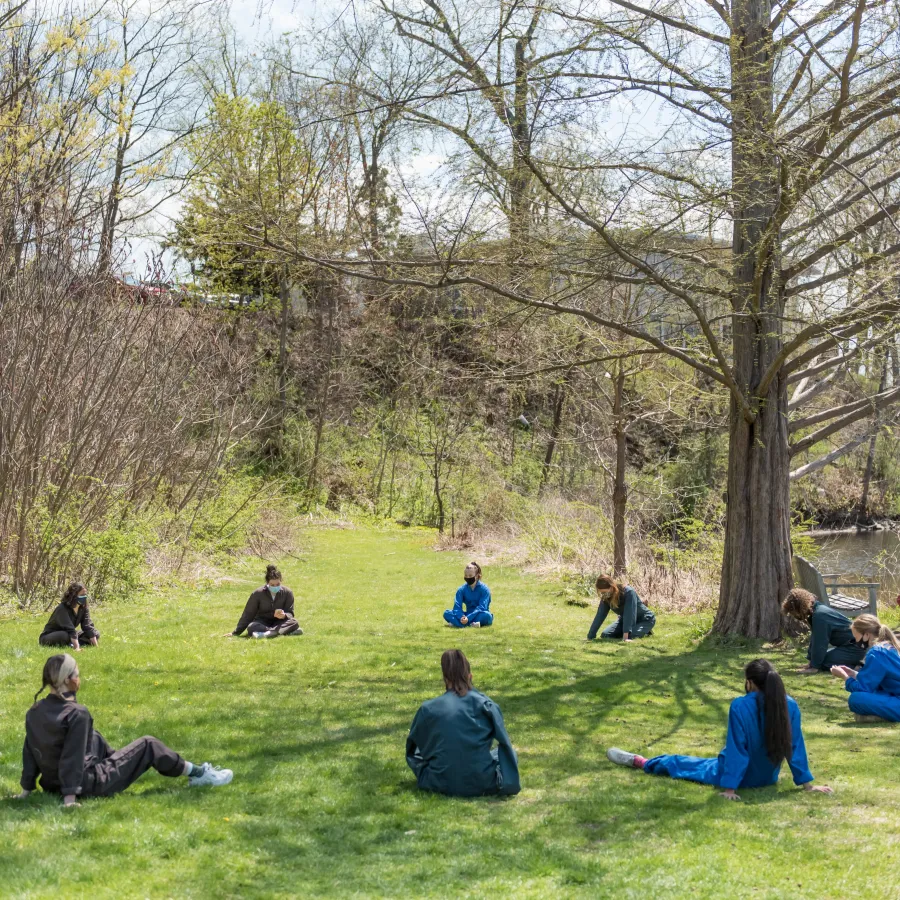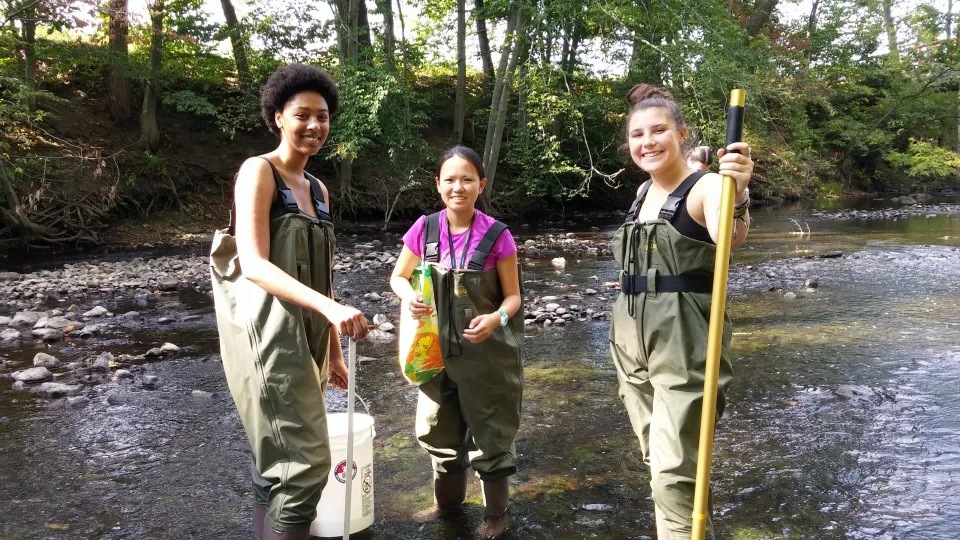When the Campus is Your Classroom
Botanic Garden - Leaflet

Published March 25, 2023
Leaflet 2022
Many students expect to enroll in a class and spend the semester learning in a fixed space: the classroom. But what happens when that class expands outside the walls of a building and spreads throughout the grounds of a campus? How is learning enhanced when the campus transforms into a student’s laboratory?
The concept of “campus as lab” is a pedagogical philosophy that’s taking hold in higher education. Experiential learning—learning that focuses on knowledge generated through direct involvement, or learning by doing—such as this has many benefits and it has been well-studied over the years. It sets students up for better academic performance as they are able to apply material to real-world situations; it helps them retain the information taught in their classes more effectively; it helps them bridge wider “knowledge gaps” for more rapid learning; and it helps students see their own impact, and how they can make a real difference.
Smith College, with its well-placed location along the Mill River and with the botanic garden so integrated into the campus, is primed for students to get outdoors and engage in experiential learning. As a result, many faculty members are taking full advantage of this beneficial situation.
For science educators, taking students out into the campus to engage in fieldwork makes their curriculum come alive because teaching is no longer confined to textbook learning; it’s happening in the real world. This is true for Marney Pratt, Ph.D. senior laboratory instructor in biological sciences, who teaches biodiversity, ecology, and conservation. Through various projects that Pratt oversees—such as observing the growth cycles of invasive plants to understand why they thrive, or taking samples of organisms and water from the Mill River, which flows into Paradise Pond, to sample macroinvertebrates—her students use the entire Smith College campus as a classroom and laboratory for learning. Through this fieldwork, students transition from being consumers of knowledge to participants in the act of generating understanding. They aren’t just reading about how invasives affect a habitat, for example, they’re seeing it happen in real time and bearing witness to its effect on their own campus.

These learning experiences ground the students in more than the content of the course; they ground them in the campus itself. “At conferences people talk about the value of place-based research and place-based education—offering students the opportunity to study not just some data we picked up from somewhere, but data from their place. It is a really useful, and powerful, way to connect students to the place,” Pratt says. Building this sense of place strengthens college students’ investment in their own intellectual growth since their subject of study is intertwined with their daily lives.
Employing the campus as a tool for learning is also a fundamental part of how Denise Lello, a lecturer and research associate in biology and environmental science and policy, connects her students with the course material. Lello has been engaging her classes in campus fieldwork for as many years as she has been teaching at Smith, and her kinetic style of teaching imprints upon her students that a powerful way to learn is by doing. Many scientists got their start as naturalists, observing migration patterns or the changing leaves around them. Lello’s students engage in a number of fieldwork exercises while in their campus lab. They observe strategically placed bird feeders to note the feeding patterns of various bird species, and collect leaf litter and soil samples at the soil interface to examine how climate change might impact the soil community over time. Through this on-campus fieldwork students are also developing the skills to become self-actualized learners. They’re practicing how to be curious about what they observe and how to feed that curiosity with learning, which opens the door for them to become natural lifelong learners. When a love of nature is combined with the honed ability to carefully observe one’s surroundings—to be deeply aware of what is, to question what is witnessed, and to transform those questions into hypotheses about how the world works—the student is learning how to fully engage in the scientific process. “Not only does it make the work much more meaningful [to the students], it makes the students more observant about where they are throughout the four years that they’re at Smith,” Lello says. “They start to see things they wouldn’t see otherwise. They notice the leaves changing on the trees. They notice that there are birds on campus. I think it helps them realize how important it is to be outside.”
The benefits of engaging in fieldwork on campus for future scientific professionals is clear: They are practicing their craft. However, this type of learning is advantageous across all disciplines. Landscape is also an asset for those in the arts. This is perhaps most clearly demonstrated by Department of Dance faculty members Chris Aiken and Angie Hauser through their course Movement, Ecology, and Performance. Created with support from the botanic garden’s Curricular Enhancement Grant Program, the course explores how place and landscape offer inspiration and opportunities for dance, performance, and embodied experience. It does so by incorporating the study of landscape, geology, anthropology, history, hydrology, and indigenous studies with the study of dance. Students hold that information as they dance, physically engaging with the landscape in new ways.

“When you look at everything—from deep time, to human time, to the history of the United States as a country—studying where you live in this intimate way is different from learning abstract knowledge of North America,” Aiken says. “We are studying the place they sleep and take classes in, and to have that place enhanced with intimate experiences such as crawling into woods, getting in the river, and climbing trees, they then develop these tactile and deep relationships with land in ways that they cannot if just walking to class. It has been awakening in our students a sensitivity to land and its long history, and the importance of being good stewards of the land.”
The course borrows an activity from Gaby Immerman, experiential learning specialist for the botanic garden and senior lecturer in biology, that she uses in her Botany for Gardeners class. The activity, called Order of Bloom, invites students to follow a bud to flower from just after the dormancy phase. Immerman has created a version of this project for Aiken and Hauser’s students, and it has added yet another layer in how students' relationship with the campus is transformed. “Through this class we have seen the students genuinely bond with land, place, and its stories,” Hauser says. “The students become a part of the land, where they now cannot not be aware that the tree is getting ready to bloom. They just see it. It’s an incredibly transformative experience for students, and for Chris and me, each time.”
An offshoot of this type of learning is that it’s not just the students in the class that benefit. Students who are walking on campus, sitting with friends, or studying on the lawn are also pulled in. Hauser says she has witnessed numerous occasions in which students passing by are attracted to the animation of the course. Mariana Abarca, assistant professor of biological sciences, agrees. Using the campus roots her students in the class content: “You take them outside and then anytime they walk outside they can remember that experience.” What’s more, she says, it “allows you to reach other students who are not in your lab because they see activity going on within the campus and it interests them. It’s a tool for education that spills out, so it's not just for my students, it is for the whole community.”
Pratt agrees. Using the campus as a lab “packs so much interest and connection,” she says. “I think that connection goes beyond just the class. It helps connect the students to biology, to nature, to campus, to Smith College in general—and beyond Smith to Northampton and the bigger community outside.”